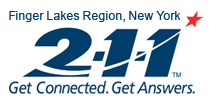
The Southern Tier CA$H (Creating Assets, Savings and Hope) Program is officially closed. However, Arbor Housing and Development is still committed to providing access to tax support throughout the Southern Tier. Beginning in 2021, visit our website for a list of free and low-cost tax services nearby and online. See information below to contact 2-1-1 for immediate assistance.
Visit http://www.211helpline.org/ or DIAL 2-1-1- or 1-800-346-2211 to speak to a call specialist for connections for services in Steuben, Chemung, Allegany, Schuyler and Yates counties.
Don’t ignore a letter from the IRS
Don’t worry if you receive one of the millions of letters the IRS sends to taxpayers every year, but don’t ignore it either. IRS letters typically are about a specific issue on your federal tax return or tax account and include specific instructions on what you need to do to respond.
Generally, the IRS sends a letter if:
- you owe additional tax;
- you are due a larger refund; or
- the IRS is requesting payment or needs additional information about your return.
Many of these letters can be dealt with simply, without having to call or visit an IRS office.
For example, you may get a letter that states the IRS made a change or correction to your tax return. If you do receive this letter, review the information and compare it with your original return. If you agree, you usually don’t need to reply unless it gives you other instructions or you need to make a payment.
However, if you don’t agree with the letter, it’s important for you to respond. Write to explain why you disagree and include any information and documents you want the IRS to consider. Mail your reply to the address shown in the letter along with the bottom tear-off portion of the letter, if provided. Keep copies of any correspondence with your tax records. Allow at least 30 days for a response from the IRS.
If you have questions, call the telephone number in the letter. Have a copy of your tax return and the correspondence available when you call.
Check Understanding Your IRS Notice or Letter on IRS.gov for samples of the letters we send, including the reason we send it and a list of enclosures we might include. Since parts of our letters vary depending on account conditions, the samples may not exactly match the letters we mail. The basic message, though, will be the same.
If you receive a letter that looks suspicious and appears as though it came from the IRS, visit the Report Phishing and Online Scams page on IRS.gov. The IRS never asks for personal information via e-mail or social media.
For more information about IRS notices and bills, see Publication 594, The IRS Collection Process. Information about penalties and interest is available in Publication 17, Your Federal Income Tax. Both publications are available at IRS.gov.
Questions on the new Tax Reform? For detailed information, visit the IRS Tax Reform page
Tax Cuts and Jobs Act (TCJA) Information The IRS issued a new publication to help taxpayers learn about tax reform and how it affects their taxes. Pub 5307 - Tax Reform Basics for Individuals and Families provides information to help individual taxpayers understand the new law, take action - if necessary - and comply with your federal tax return filing requirements.Tax Reform Provisions that Affect Individuals
Tips to Get the Most Value from Your Tax Refund
- Pay down your debt. Use your refund for some much needed debt relief. Pay off your credit card balance. If you have an outstanding balance on more than one credit card, try to pay off the smaller, high-interest rate balances first. That will free up more funds to put toward larger balances. Alternatively, you can apply your refund toward other debts, like a car loan or a home equity loan.
- Save for a rainy day. Why not give yourself an even bigger return on your tax refund by putting the money into a savings account, CD, retirement fund, or purchasing a tax time savings bond? Your tax refund will continue to grow if you put it into savings or invest the money. It's always helpful to have a savings account to draw from when a major car repair bill, medical emergency or other unexpected expense comes along. That way, you don't have to borrow money and add to your debt-load.
- Consider your financial goals. Trying to save for a house or car down payment? Hope to contribute to your child's college tuition? Consider applying your tax refund toward these goals. If you don't yet have a set of short-term and long-term financial goals, put one together. You'll be more conscientious about how you spend your refund or any other extra money that comes your way.
Free Online Information and Tools
There are many resources to help you improve your personal finance skills. Below is a list of some free, self-paced, online financial education resources:
Save and Invest - A well-rounded guide to budgeting, saving and investing. Tools and information on this website were designed for military families, but apply to everyone.
Hands on banking.org - Online courses for children, teens, and adults. Courses are available in Spanish. The website offers basic money tools, skills, and information.
My Money - The U.S. government’s website dedicated to teaching all Americans the basics about financial education.
Money Smart - Game-based learning for adults and young adults. An easy-to-use website to learn more about basic personal financial management.
Smart About Money - Website of the National Endowment for Financial Education (NEFE) a nonprofit national foundation dedicated to inspiring empowered financial decision- making for individuals and families through every stage of life. Articles, resources, calculators and tips to help you manage your money.
Better Money Habits - Build your financial know-how with free tools and information to help you make more confident decisions. It's a simple way of getting real, practical knowledge, brought to you by Bank of America in partnership with Khan Academy.
Filing Your Own Taxes
United Way offers a free online filing service that you can use anywhere. MyFreeTaxes.com is a tool (H&R Block software) for people who made $66,000 or less in combined Adjusted Gross Income (AGI) in 2018. You can prepare and file both federal and state taxes at no cost, and claim valuable tax credits like the Earned Income Tax Credit (EITC). Just click the orange button for "Login", then click "Go to H&R Block" to go the to website to create your account, or login to your existing account.
To ensure that you are filing for free - please use the online software available on the NYS Department of Taxation and Finance Free File Alliance Webpage.
Tax Web Sites:
IRS website for general information
New York State Forms and Publications
Pennsylvania Forms and Publications
To request your IRS Federal transcript:
- To order a transcript online and have it sent electronically, use the IRS Get Transcript tool, simply click the "Get Transcript Online" button.
- To order a transcript online and have it delivered by mail, use the IRS Get Transcript tool, simply click the "Get Transcript by Mail" button.
- To order by phone, call 800-908-9946 and follow the prompts
To get a copy of your New York State return:
- To order transcripts online, log in or create an Online Services account to view and print a copy of your e-filed return, go to NYS Department of Taxation and Finance website, and click on Get a copy of my return
- To request copies of e-filed or paper returns for tax years 1990 and forward, complete and mail Form DTF-505, Authorization for Release of Photocopies of Tax Returns and/or Tax Information. Returns filed before 1990 are not available.
Need to amend your tax return?
To claim a refund, you generally must file Form 1040X within three years from the date you filed your original tax return or within two years from the date you paid the tax, whichever is later. Normal processing time for amended returns is 8 to 12 weeks. If you think that you need to amend your return, review IRS Amended Return 1040X Tips and utilize Form 1040X or call (800) TAX-FORM (800-829-3676).
Need a copy of your W2?
If you lost or never received your W2, call the IRS at this number: (800) 829-0922. If the IRS does not have the information, an IRS representative will send a formal request to your employer to provide the W2 within 10 days.
Taxpayer Advocate Services: Helping You Resolve Tax Problems
Federal
The Taxpayer Advocate Service (TAS) is an independent organization within the IRS that helps taxpayers who are experiencing unresolved federal tax problems. You may be eligible for our help if you've tried to resolve your tax problem through normal IRS channels and have gotten nowhere, or you believe an IRS procedure just isn't working as it should.
- Visit irs.gov/advocate
Call toll-free at (877) 777-4778
New York State
Having difficulty resolving a tax issue through regular channels at the Department of Taxation and Finance? As an independent organization within the department, the Office of the New York State Taxpayer Rights Advocate is committed to helping New York State taxpayers by balancing taxpayer assistance against enforcement efforts.
How to request information assistance:
- Call (518) 530-HELP (4357); OR
-
Fax completed Form DTF-911 to (518) 435-8532 or mail it to:
New York State Department of Taxation and Finance
Office of the Taxpayer Rights Advocate
W. A. Harriman Campus, Building 9
Albany, New York 12227
Identity Theft
IRS will Provide Copies of Returns to Victims of Identity Theft
IRS has agreed to provide victims of identity theft with copies of the fraudulent tax returns filed using their personal and financial information. Prior to this change, victims were notified that some or all of their information had been used to file fraudulent returns but no further information was made available. That left some taxpayers concerned about the amount of information that third parties had about their personal and financial details.
If a taxpayer who is a victim of Identity Theft wants a copy of the fraudulent return filed against them, it can be provided. They need to call 1- 800-829-1040 and request a copy of the ID Theft return. Redacted returns are necessary because multiple Social Security numbers could be on a single tax return. Releasing tax returns which have multiple Social Security numbers prior to redaction could compromise someone else’s identity.

